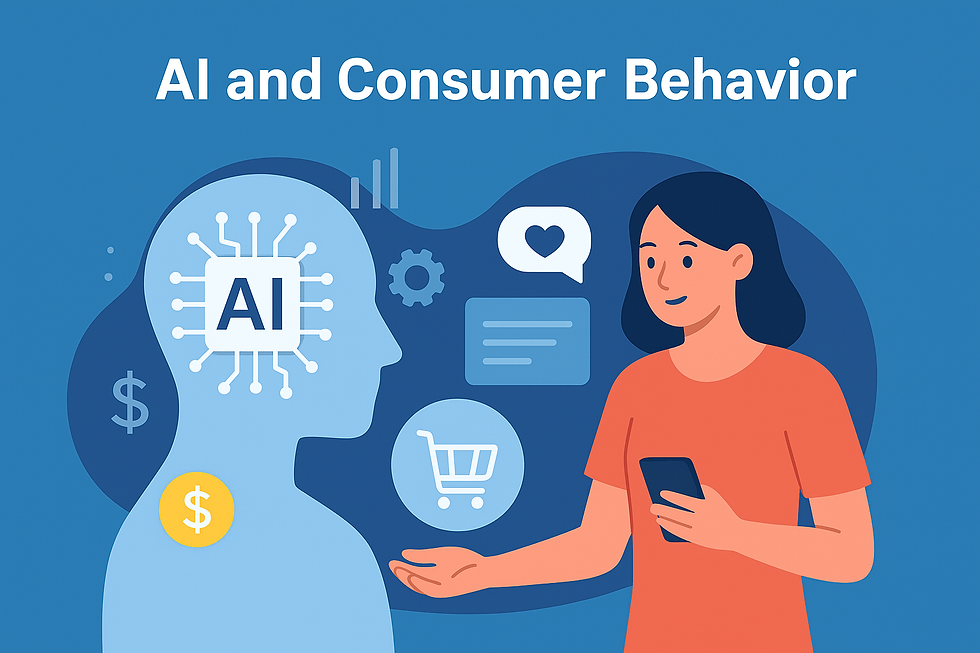AI and Consumer Behavior: 7 Powerful Insights for Growth
- varshavaru369
- Aug 20
- 4 min read

Artificial Intelligence (AI) is no longer a futuristic concept—it’s a driving force shaping modern markets. AI and consumer behavior are now deeply interconnected, giving businesses unprecedented access to customer insights. From predicting buying patterns to delivering hyper-personalized experiences, AI is changing how consumers make decisions—and how brands respond.
In this blog, we’ll uncover 7 powerful insights on AI and consumer behavior that businesses can leverage to drive growth, stay competitive, and build lasting customer relationships.
Why AI and Consumer Behavior Matter
Understanding consumer behavior has always been central to business success. Traditionally, marketers relied on surveys, focus groups, or historical data. But these methods are slow, often biased, and limited in scope.
With AI, businesses can analyze massive datasets in real-time, detect hidden patterns, and forecast future behavior. This shift is fueling new consumer behavior trends with AI, allowing businesses to move from reactive to proactive strategies.
👉 According to McKinsey, AI adoption has doubled in the last five years, with customer analytics ranking among the top areas of investment.
7 Key Insights on AI and Consumer Behavior
1. Hyper-Personalization Is Redefining Customer Experience
Consumers expect brands to understand their unique preferences. With AI-driven consumer insights, businesses can tailor product recommendations, content, and offers.
Example: Netflix uses AI to predict what users will enjoy next.
Impact: Higher engagement, stronger loyalty, and improved sales.
2. Predictive Analytics Anticipates Consumer Needs
The impact of AI on consumer behavior is evident in predictive analytics. AI models forecast what a customer is likely to purchase based on browsing history, purchase frequency, and even social interactions.
Retailers like Amazon excel in predicting demand before customers realize their need.
Benefit: Businesses can optimize stock, reduce costs, and increase customer satisfaction.
3. Emotional AI Enhances Customer Interactions
AI doesn’t just analyze data—it can also detect human emotions through voice, text, and facial recognition. This creates opportunities to personalize interactions beyond demographics.
Example: Chatbots powered with emotional AI respond empathetically to frustrated customers.
Result: Improved customer service and stronger brand trust.
4. Voice Assistants Are Changing Buying Behavior
Voice-activated devices like Alexa, Siri, and Google Assistant are transforming shopping habits. AI in customer behavior analysis shows that more people prefer convenience-driven voice searches.
Businesses must optimize for voice search and conversational AI.
Trend: Impulse purchases are rising due to ease of one-command shopping.
5. AI Identifies Micro-Trends Instantly
Consumer preferences evolve rapidly. With AI, brands can monitor social media conversations, reviews, and online activity to detect micro-trends.
Example: Fashion retailers use AI to identify viral styles early.
Advantage: First-mover benefit in capturing new markets.
6. Fraud Detection Protects Consumer Trust
With rising digital transactions, consumers value security. AI’s role in monitoring unusual spending patterns reduces fraud and reassures customers.
Banks use AI to flag suspicious activities instantly.
Impact: Safer transactions and stronger customer confidence.
7. AI Fuels Data-Driven Decision Making for Growth
The impact of AI on consumer behavior extends to strategic planning. By analyzing buying journeys, feedback loops, and churn patterns, companies gain a 360° view of customers.
This allows businesses to adjust pricing, design loyalty programs, and predict future demand.
Challenges of Using AI in Consumer Behavior Analysis
While the benefits are clear, businesses face challenges:
Data privacy concerns: Consumers are increasingly cautious about data sharing.
Bias in algorithms: Poorly trained AI can misrepresent consumer groups.
Integration issues: Legacy systems often struggle to adopt AI smoothly.
Despite these hurdles, the advantages outweigh the risks—if businesses use AI responsibly.
Future of Consumer Behavior Trends with AI
Looking ahead, AI and consumer behavior will continue to merge in exciting ways:
Immersive shopping experiences powered by AR/VR.
Real-time customer feedback through AI sentiment analysis.
Sustainable consumer behavior prediction for eco-conscious markets.
Businesses that embrace AI today will shape the consumer experiences of tomorrow.
How Businesses Can Leverage AI and Consumer Behavior
Invest in AI tools for personalization and predictive analysis.
Focus on transparency to build customer trust in AI-driven insights.
Integrate cross-channel data for a unified view of consumer journeys.
Train teams to work with AI systems, not against them.
For a detailed guide, check out Forbes on AI in Consumer Behavior.
Conclusion
AI is revolutionizing how businesses understand and respond to customers. From AI-driven consumer insights to predicting future trends, AI and consumer behavior form the backbone of modern business strategies. Companies that adapt quickly will not only grow but also lead markets by delivering smarter, faster, and more personalized consumer experiences.
👉 If you’re interested in digital transformation strategies, explore our AI in Business Strategy guide for deeper insights.
FAQs on AI and Consumer Behavior
1. How is AI influencing consumer behavior today?
AI is transforming consumer behavior by enabling hyper-personalization, predictive analytics, and real-time customer engagement. It helps businesses understand needs before consumers express them.
2. What are the key consumer behavior trends with AI?
Major trends include personalized recommendations, voice-assisted shopping, emotional AI in customer service, fraud detection, and micro-trend identification through social listening.
3. What is the impact of AI on consumer behavior in retail?
In retail, AI influences behavior by offering tailored product suggestions, forecasting demand, reducing cart abandonment, and enhancing customer experiences through personalized marketing.
4. How do businesses use AI in customer behavior analysis?
Companies use AI tools to analyze purchase history, browsing patterns, social interactions, and sentiment to predict future actions and improve marketing strategies.
5. What are AI-driven consumer insights?
AI-driven consumer insights are actionable findings derived from AI algorithms that analyze large datasets. They reveal customer preferences, emerging trends, and buying motivations.
6. What challenges do businesses face in using AI for consumer behavior?Challenges include data privacy concerns, algorithmic bias, system integration issues, and ensuring transparency to maintain consumer trust.




Comments